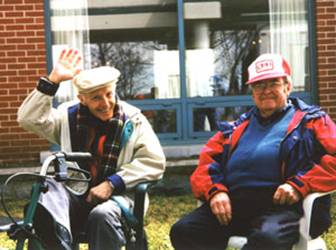|
|
Nursing Homes Shift Into Rehab Services: More Than Half of Those Admitted Stay A Month or Less
By Charles Stein, The Boston Globe
August 15, 2005

Linda Richards has been in a nursing home for two days. In a few days, she expects to go home.
In her bed at the Rosewood Nursing and Rehabilitation Center, Richards is hooked up to a mechanical device that regularly lifts her newly replaced knee and then sets it down again. Before she leaves the nursing home she will have to be able to bend the knee at a 90-degree angle. A cheerful 63-year-old, Richards insists she will be on her feet and back to work in a matter of weeks.
''Maybe I'll even take up downhill skiing," she said with a laugh.
Richards, interviewed at Rosewood earlier this month, could be the poster child for the modern nursing home. The very old and very sick still come to nursing homes at the end of life. Richards's mother spent her final days at Rosewood.
But increasingly, patients come for short stays and go home. They recover from knee and hip replacements or learn to speak again after strokes. Many are quite old, yet a number, like Richards, are not even senior citizens.
''Nursing homes aren't just the place on the hill you go to die," said Scott Plumb, an executive with the Massachusetts Extended Care Federation, a trade group for the state's nursing homes.
According to the federation, 55 percent of those admitted to nursing homes stay less than a month and more than 70 percent stay less than three months. About half of those who leave today return to their homes. Twenty years ago, only 20 percent could make the same claim.
The combination of an aging population that needs rehabilitation and new government rules aimed at holding down medical costs all but guarantees the shift toward shorter stays at nursing homes will continue.
''It is not a revolution, but a gradual evolution," said Marva Serotkin, chief executive of The Boston Home, a Dorchester nursing home.
The transformation of nursing homes got its initial push from higher up the healthcare chain.
Under pressure from insurance companies, hospitals began discharging patients sooner. The result was that people leaving the hospital were too sick to go home.
Historically those patients went to rehabilitation hospitals such as Spaulding Rehabilitation Hospital in Boston. Some still do. But many don't need the high-level services the rehabilitation hospitals provide.
And insurers, including Medicare, the government program that pays medical bills for seniors, wanted a cheaper place to send patients who could get by with less intensive therapy.
Medicare pays roughly $320 a day for nursing home care and more than $800 a day for treatment at a rehabilitation hospital.
At the same time, nursing homes had empty beds to fill. ''When I started in this business 21 years ago, we took care of little old ladies in walkers," said Richard Bane, president of the management company that runs Rosewood.
Over the past decade those seniors who were frail, but not terribly sick, found other places to go. Some stayed at home with the help of home care; others moved to assisted-living facilities. The remaining nursing home population got older, sicker, and smaller.
By shifting into rehabilitation, nursing homes filled some of those empty beds and put themselves into a very different business from the one they traditionally practiced.
Many of those changes are obvious at Rosewood. Although no one would confuse the home with Club Med, there is a surprising amount of activity.
Outside, patients in wheelchairs and walkers visit with relatives on a sunny summer day.
Inside, therapists use several small gyms to help patients learn to climb steps and get out of bed without assistance.
The home also has a model kitchen and bathroom where residents can practice cooking and getting in and out of the shower.
People who have had hip and knee surgery constitute a large fraction of the rehabilitation patients. Nationally, 418,000 people each year get new knees and 220,000 get new hips, numbers that are expected to climb steadily in the future.
Other patients are treated for strokes, wounds that demand regular dressing, and infections that require intravenous therapy.
What the patients have in common is that they are not in the home to stay. Rosewood's typical short-term patient leaves after two weeks.
The rise in short-stay patients has forced nursing homes to make major adjustments. The homes need more nurses with different skills and more administrators to handle the frequent discharges.
Like many nursing homes, Rosewood puts its rehabilitation patients and its long-term patients in separate units.
Connie Paullis, an administrator at Rosewood, says some short-stay patients are happy to participate in the activities aimed at the traditional nursing-home patients. ''Others don't want to see the regular nursing home population," she said.
Tori Sullivan, Rosewood's director of nursing, agreed that the public perception of nursing homes has not caught up with the changes in the business. ''People still hear the word 'nursing home' and get scared," she said. ''They think it is still a place where you don't go home."
If Washington has anything to say about it, more nursing home patients will be going home. Federal regulators recently approved a regulation known as the ''75 percent rule" that will require rehabilitation hospitals to demonstrate that they are treating patients who need high levels of care.
Patients who require less will be diverted to nursing homes, a move that Medicare expects to result in substantial savings.
Robert Laszewski, who writes a newsletter on health policy in Washington, said the two industries -- nursing homes and rehabilitation hospitals -- fought for years to get Medicare to tailor the regulation in their favor.
''In the end," Laszewski said, ''nursing homes were the big winners."
|
|



